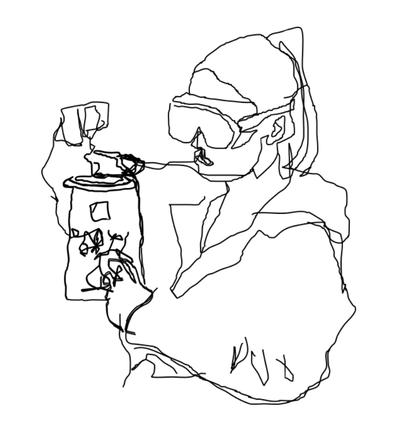A collection of chemical weapons laid out in organized piles on a white background. There are (counter clockwise from the top left) four triple chaser grenade pieces, 4 full grenades, two dozen grenade clips, over 60 skat pellets, 4 skat shells, 7 grenade pins, a variety of overshot wad (aka pogs), FN303 rounds (yellow, pink, red, clear), handball grenade pieces and rubber buckshot, and red and purple pepperballs). You can smell the corrosion on the air.
Rough pen sketch of a person with hair pulled back in a ponytail in goggles and a lab coat holding a chemical grenade, with one hand on the side/bottom and one hand on the fuse top.
Chemical Weapons Research Center
Advancing our understanding of how chemical weapons affect people and the environment.

Formed during the Black Lives Matter protests in Portland, Oregon, we are a collection of researchers, science communicators, and advocates focused on understanding the impact of chemical weapons on humans and the environment. Our projects are diverse, but we are brought together by an urgent need to understand what chemicals are being used by military and law enforcement and how they are affecting all of us.
Dr. Juniper L. Simonis (she/her), Lead Scientist DAPPER Stats
Executive Director, Principal Scientist
Dr. Kate Ellenberger (she/her), Owner Heritech Consulting
Collections Manager
Jake Dockter (he/him)
Advocacy & Outreach
James Croxton (he/him), Editor-In-Chief Double Sided Media
Researcher
Dr. David Dayan (he/him)
Researcher
Support Our Work
Our members are engaged in a variety of projects that need support; please help if you can!
Analyzing Chemical Weapons Residue
We are working with local university researchers and Specialty Analytical to understand the impact of chemical weapons residues in Portland OR’s parks, schools, houses, and rivers. A key component of this work is the identifying and measuring of compounds in the samples, which requires expensive equipment and reagents as well as staff with specialized skills. This campaign is targeted at funding the processing of samples collected in an elementary school playground, where Department of Homeland Security agents deployed toxic chemical weapons.
Prior to this campaign, all of the chemical weapons research had been funded completely through DAPPER Stats' internal funds.
Get Involved
Interested in getting hands on in your support? There are so many ways to help out!
There are countless research questions that could use answers, so if you’re keen to science some stuff, please reach out!
We’re currently working up descriptions of specific tasks or projects we could use help with, so stay tuned! Contact us for more information in the meantime!